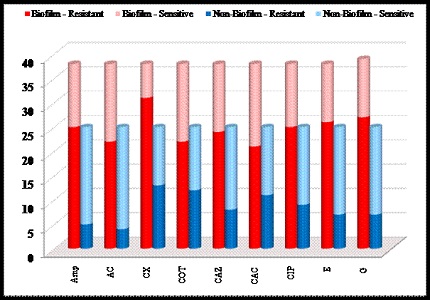Detection of Biofilm production in microorganisms complicating Chronic wound infections
Abstract
Introduction: The presence of biofilm facilitates the development of infections by compromising the immune system of the patient and by contributing to the failure of antibiotic therapy, which may result in recurrent infections and the emergence of multidrug resistant pathogens.
Objectives: The objective of this study is to determine the biofilm forming ability of the microorganisms infecting chronic wounds and to correlate the drug resistance with biofilm formation.
Material and Methods: Wound swabs were collected from 50 patients with non-healing ulcers. Microorganisms isolated by standard microbiological techniques were screened for biofilm production by tissue culture plate method. Antibiotic sensitivity tests were done for appropriate panel of antibiotics by Kirby Bauer disc diffusion test.
Results: All the 50 samples were culture positive. The most common organism isolated was Staphylococcus aureus, CoNS, Enterococcus faecalis, Beta hemolytic Streptococci, Pseudomonas aeruginosa, Escherichia coli, Klebsiella pneumonia, Acinetobacter and Proteus vulgaris. Biofilm formation was determined by Tissue Culture Plate method in 63 identified isolates (39 in monomicrobial & 24 in polymicrobial infections) and 38 (60.32 %) isolates were positive for biofilm production. Most of the isolates in polymicrobial infections were strong biofilm producers. Biofilm producers were found to be more resistant to almost all the groups of antibiotics.
Conclusion: If we understand the wound's microbial flora, it allows us to manage and treat the wound better. New strategies targeting biofilm disruption or prevention of biofilm formation are important new approaches in the management of chronic wounds.
Downloads
References
2. Bowler PG, Davies BJ. The microbiology of infected and noninfected leg ulcers. Int J Dermatol. 1999 Aug;38(8):573-8. [PubMed]
3. James GA, Swogger E, Wolcott R, Pulcini Ed, Secor P, Sestrich J, Costerton JW, Stewart PS. Biofilms in chronic wounds. Wound Repair Regen. 2008 Jan-Feb;16(1):37-44. Epub 2007 Dec 13. [PubMed]
4. Brown MR, Allison DG, Gilbert P. Resistance of bacterial biofilms to antibiotics: a growth-rate related effect? J Antimicrob Chemother. 1988 Dec;22(6):777-80. [PubMed]
5. Mathur T, Singhal S, Khan S, Upadhyay DJ, Fatma T, Rattan A. Detection of biofilm formation among the clinical isolates of Staphylococci: an evaluation of three different screening methods. Indian J Med Microbiol. 2006 Jan;24(1):25-9. [PubMed]
6. Christensen GD, Simpson WA, Younger JA et al. (1995) Adherence of coagulase negative Staphylococci to plastic tissue cultures: a quantitative model for the adherence of Staphylococci to medical devices. J Clin Microbiol. 1985 Dec; 22(6): 996–1006.
7. Hassan A, Usman J, Kaleem F, Omair M, Khalid A, Iqbal M. Evaluation of different detection methods of biofilm formation in the clinical isolates. Braz J Infect Dis. 2011 Jul-Aug;15(4):305-11. [PubMed]
8. Brook I, Frazier EH. Aerobic and anaerobic microbiology of chronic venous ulcers. Int J Dermatol. 1998 Jun;37(6):426-8. [PubMed]
9. Costerton W, Veeh R, Shirtliff M, Pasmore M, Post C, Ehrlich G. The application of biofilm science to the study and control of chronic bacterial infections. J Clin Invest. 2003 Nov;112(10):1466-77. [PubMed]
10. Anwar, H., Strap, J.L., and Costerton, J.W. (1992) Establishment of aging biofilms: a possible mechanism of bacterial resistance to antimicrobial therapy. Antimicrob Agents Chemother. 1992 Jul; 36(7): 1347–1351.
11. Brown MR, Allison DG, Gilbert P. Resistance of bacterial biofilms to antibiotics: a growth-rate related effect? J Antimicrob Chemother. 1988 Dec;22(6):777-80. [PubMed]
12. Stewart PS, Costerton JW. Antibiotic resistance of bacteria in biofilms. Lancet. 2001 Jul 14;358(9276):135-8. [PubMed]



 OAI - Open Archives Initiative
OAI - Open Archives Initiative


